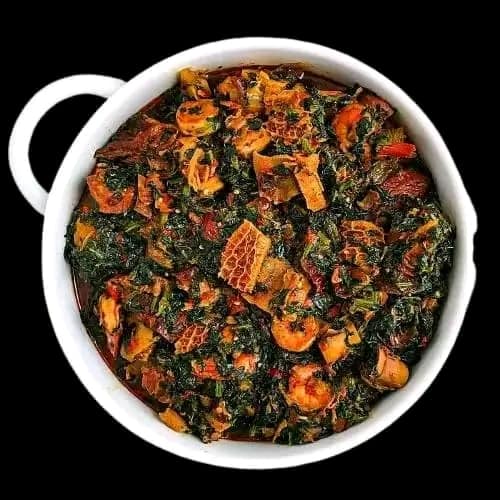- Preparation of Ingredients:
- Wash and chop the leafy greens into bite-sized pieces. If using spinach, blanch quickly in boiling water, then squeeze out excess water.
- Prepare your meats by cleaning and cutting them into desired sizes. Pre-cook tougher meats to tenderize them.
- Blend the tomatoes, bell peppers, and scotch bonnet peppers into a smooth paste.
- Cooking the Meat:
- In a large pot, heat a generous amount of palm oil until hot, then add sliced onions and sauté until translucent.
- Add the cleaned meats and fry lightly. Include smoked fish or shrimp as preferred.
- Pour in the blended pepper mixture and cook until the oil begins to separate from the sauce.
- Building the Stew:
- Add locust beans, seasonings, and any additional spices. Allow the mixture to simmer, stirring occasionally, until the flavors meld together and the sauce thickens.
- Adjust seasoning as needed during cooking. Make sure the meat is tender and well-seasoned.
- Adding the Greens:
- Add the prepared greens to the pot, stirring them into the sauce until fully incorporated. Let them cook for about 5 to 10 minutes. Avoid overcooking the greens to preserve their vibrant color and nutrients.
- Final Adjustments:
- Taste and adjust the seasoning of the stew. The consistency should be thick, but not dry, with a generous amount of sauce.
- Serve hot.
Serving Suggestions:
Efo Riro is traditionally served with a starchy side such as pounded yam, fufu, or white rice, which complements the rich and spicy stew. It can also be enjoyed with other sides like amala (yam flour dumpling) or eba (cassava flour dumpling).
Conclusion and Additional Tips:
Efo Riro is more than just a meal; it’s a celebration of Yoruba culture and cuisine. Each ingredient adds its unique flavor, making the dish complex and deeply satisfying. For an authentic taste, try to source ingredients like locust beans and native Nigerian greens. Always use palm oil for its distinctive taste and color, which are central to the dish’s identity.
Would you like to continue with more detailed explanations of the nutritional benefits of Efo Riro or explore other traditional Nigerian dishes?
